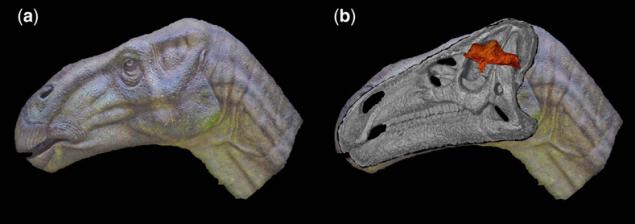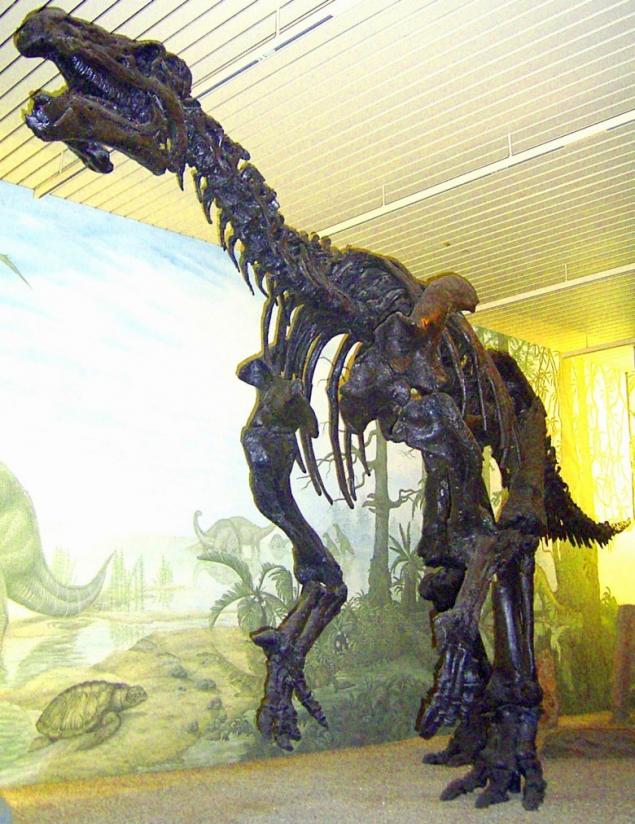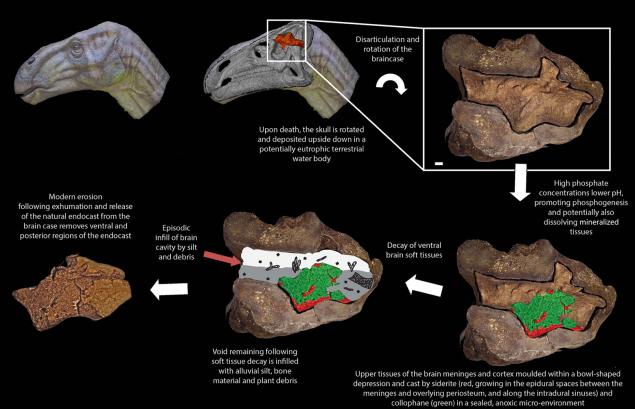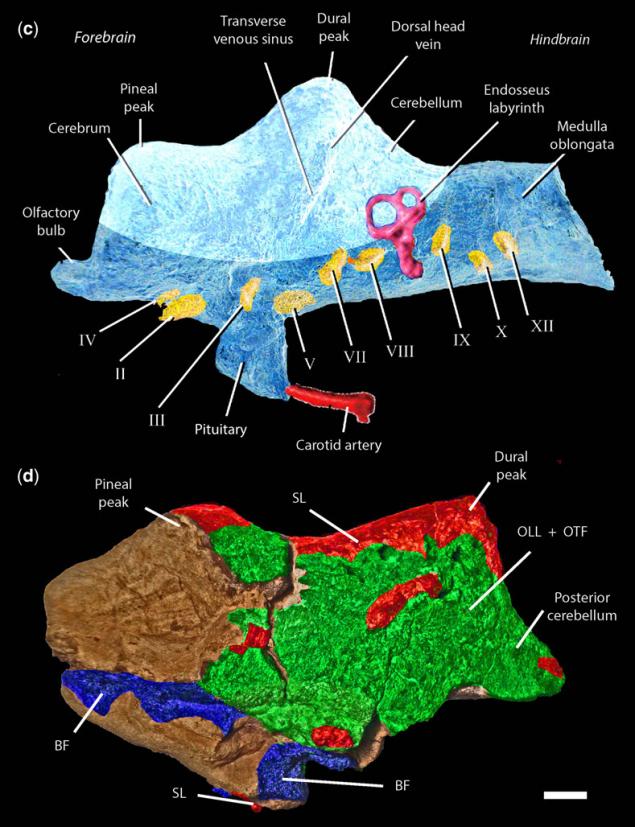Dinosaurs could be smarter than assumed. Fossilized brain iguanodont examined under a microscope
 Bashny.Net
Bashny.Net

The brain and its location is schematically shown on the background of the head iguanodont
Fossils of soft tissues of ancient animals, some very extensively studied. There are samples from throughout the Phanerozoic (he began his 542 million years BC, still ongoing). There are even samples of late Neoproterozoic, which preceded the Phanerozoic. The scientific discussion of the structure of soft tissues and brain of ancient sea invertebrates. Quite another thing — the fossils of the soft tissues of vertebrates, especially terrestrial. It is very rare.
Among these rare finds the most valuable are the fossilized remains of the brain, because the soft tissue of the brain is very fragile by nature. By and large, we know virtually nothing about the brain of ancient vertebrates that lived half a billion years ago. How was the brain developed and how? These data, scientists obtained mainly from indirect sources, not from observations.
Such indirect sources was the comparative anatomical studies of closely related extant taxa, the study of the insides of fossil skulls — endocrine, that is relief on the inner side of the skull, reflecting a pattern of large furrows and convolutions of the brain and, in some cases, large blood vessels. Endocrine possible to draw conclusions about the form and structure of the brain using 3D reconstruction. For example, see the work of Kurochkin with colleagues in 2007 with the study of the avian brain in the fossils found in the sediments of the section Melovatka−3 in the Volgograd region (Russia). This is one of the most detailed scientific papers on this subject in the world of science.
Finds of fossils of ancient terrestrial vertebrates with endocrinol — rare events (often internal relf of the skull is preserved well enough). But fossils of soft brain tissues of terrestrial organism, scientists have never managed to get.
Surprisingly, despite the absence of the object of research, scientists have spent much effort studying the brains of dinosaur skulls. The first well-preserved skull of a dinosaur was found in 1871. After 26 years, the scientists explored the inside of the skull iguanodont, trying to determine the functional divisions and the structure of his brain. Iguanodont of herbivorous ornithischian dinosaurs that lived in Europe and other regions 140-120 million years ago. Including on the territory of Russia, Ukraine and Belarus.

Skeleton iguanodont in the Museum of Bremen
In 1977 David Norman have examined in some detail the structure of the brain iguanodonta endocrine with the details of the morphology of the circulatory, nervous, and vestibular systems.
At the same time, scientists were inclined to believe that the pressure of the brain on the skull of the adult dinosaur was low. This means that the internal form of the skull was formed from them at an early age, when the skull does not keep pace with brain growth. Accordingly, held the above-mentioned study of endocrine have more to do with an underdeveloped brain in the early stages. The adult dinosaur, figuratively speaking, in a large skull could be hiding little brain, and all the rest of the space is filled with different content. At least, until now, there was a common way that the dinosaurs in the brain was not enough gray matter. As in modern reptiles, which have between brain and skull is a thick protective layer. Experts suggest that the dinosaurs could also be.
In 2016, scientists first got access to and has carefully studied the real fossils of a dinosaur's brain. This is again iguanodon. The sample collector was found on the coast in the vicinity of the resort town of Bexhill in Sussex in the South East of England, in sediments from the early Cretaceous period (≈133 million years ago).

The place of discovery of fossils of the brain
The study of fossils with a scanning electron microscope revealed the detailed structure of the brain, including the meningeal tissue, blood vessels (including capillaries), and former external cortical tissue, which belong to the cortex of the brain. In the fossil record they are replaced by calcium phosphate, that is kolofana. This is the uniqueness of the findings is the first sample that was partially mineralized even the cortex of the hemispheres.
The whole process of mineralization of the brain is schematically shown in the illustration. Bottom left shows a detail of the fossils, which have survived to the present time. This is about the third part of the dinosaur's brain volume. Green color corresponds to cellophane, red siderite, that is, the carbonate of iron is also the material of sedimentary origin, it is often found in limestone.

According to scientists, the brain of a dinosaur is so well preserved due to the fact that prior to mineralization it quickly is marinated (casalilla). Perhaps a dinosaur after his death fell into the water, and then his skull was stored in the bottom sediments of a river or lake.

Having studied fossils of brain tissue, scientists can say that this iguanodont there is such a thick protective layer between the brain and skull. Protective membrane he thickness of only 1 mm. that means that dinosaur brain fills most of the space of the skull, approximately as in modern birds.
This in addition means that iguanodon had a much higher intelligence than previously assumed, if the relative volume of the brain corresponds to the level of mental activity of the animal.
However, it is likely that under the influence of gravity fossils could flatten protective membrane, so for full confidence in a higher intelligence of dinosaurs, it is desirable to find other examples of fossils of the brain.
Scientific work published in the edition of the London geological society (doi: 10.1144/SP448.3, pdf).
Source: geektimes.ru/post/281968/
Tags
See also
Ivan Pigarёv: "Sleep is not a waste of time, and the medicine"
10 incredible discovery, who can not explain Historians
Comets and meteorites eyes of scientists and artists of past centuries
Know before you thought your intuition!
The iceberg of the brain: our subconscious mind is smarter than we thought
Why I am not a Democrat. Manifest disillusioned intellectual
The mushrooms had settled on the plants through bacterial genes
Dolphins have lived on Earth much earlier than thought
It could be your body

















